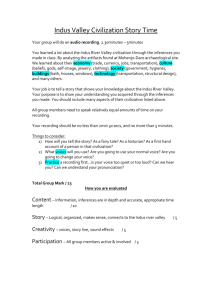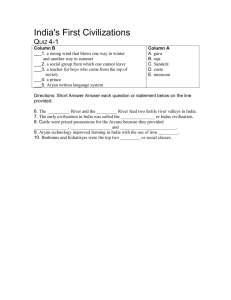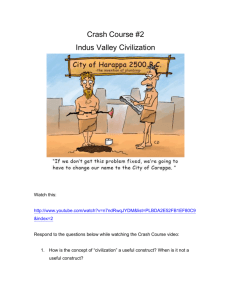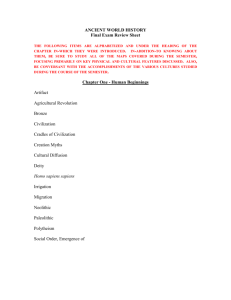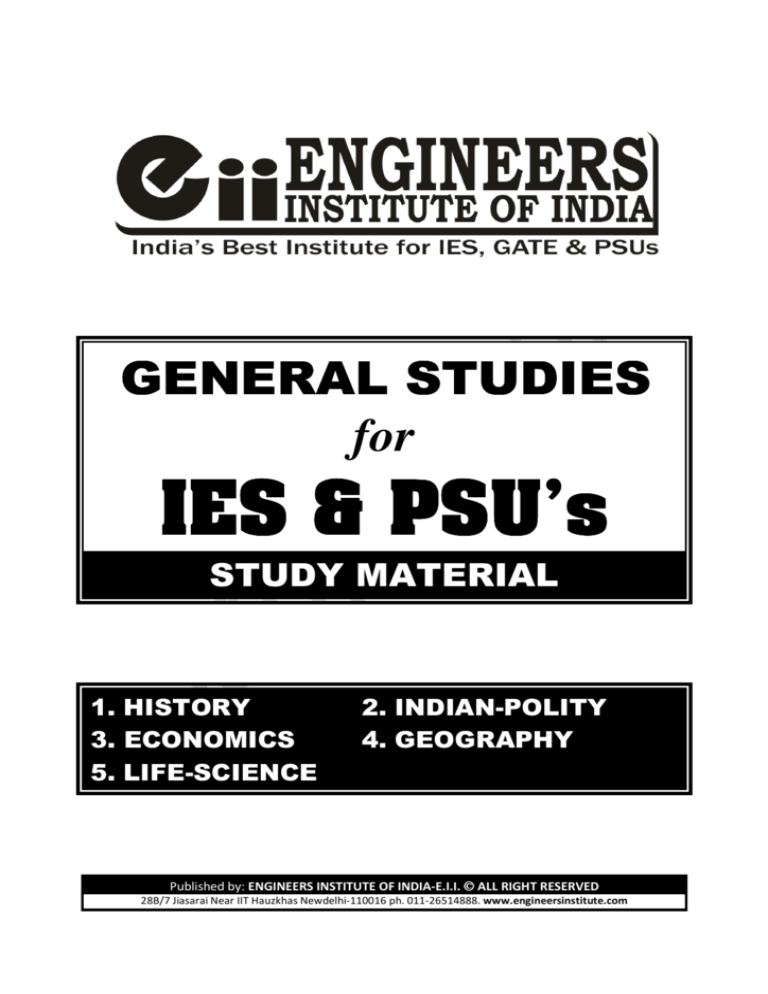
GENERAL STUDIES
for
IES & PSU’s
STUDY MATERIAL
1. HISTORY
3. ECONOMICS
5. LIFE-SCIENCE
2. INDIAN-POLITY
4. GEOGRAPHY
Published by: ENGINEERS INSTITUTE OF INDIA-E.I.I. ALL RIGHT RESERVED
28B/7 Jiasarai Near IIT Hauzkhas Newdelhi-110016 ph. 011-26514888. www.engineersinstitute.com
2014 By Engineers Institute of India
ALL RIGHTS RESERVED. No part of this work covered by the copyright herein may be
reproduced, transmitted, stored or used in any form or by any means graphic, electronic, or
mechanical, including but not limited to photocopying, recording, scanning, digitizing, taping,
Web distribution, information networks, or information storage and retrieval systems.
Engineers Institute of India
28-B/7, Jia Sarai, Near IIT Hauz Khas New Delhi-110016
Tel: 011-26514888
Publication Link: www.engineersinstitute.com/publication
ISBN: 978-93-5156-847-6
Price: Rs. 375.00
Published by: ENGINEERS INSTITUTE OF INDIA-E.I.I. ALL RIGHT RESERVED
28B/7 Jiasarai Near IIT Hauzkhas Newdelhi-110016 ph. 011-26514888. www.engineersinstitute.com
A word to the students
Knowledge of General Studies is very important to score a good marks into
examinations like Engineering services
services-UPSC,
UPSC, Civil Services, State public
service commissions, State engineering services, State Electricity board, SSC,
Public sector undertakings & many promising and prestigious competitions.
Preparation for General Studies can’t be underestimate as it is compulsory to
qualify for many exams; this may contribute your score upto top ranks with
final selections. You need to plan your study as per recen
recent examination pattern,
which help you to understand the core area to focus in more details. Over the
past few years, it has become more competitive as a number of aspirants are increasingly
becoming interested in government jobs due to decline in other car
career
eer options.
In my opinion, syllabus is quite large in General Studies, so selective preparations are best way
to deal & qualify such exams. Competitive examinations rigorously tests candidates’ overall
knowledge & understanding of concepts, ability to ap
apply
ply their knowledge and personality level
by screening them through various stages. A candidate is supposed to smartly deal with the
syllabus not just mugging up concepts. Thorough understanding with critical analysis of topics
and ability to express clearly
ly are some of the pre
pre-requisites
requisites to crack this exam. The syllabus and
questioning pattern has remained pretty much the same over the years. Conventional paper
practice is very important to score good marks, as it checks your writing skills, deep
understanding of a subject.
Established in 2006 by a team of IES and GATE toppers, we at Engineers Institute
Instit
of IndiaE.i.i have consistently provided rigorous classes and proper guidance to engineering students
over the nation in successfully accomplishing their dreams. We believe in providing examoriented teaching methodology with updated study material and test series so that our students
stay ahead in the competition. The faculties at EII are team of experienced professionals who
have guided thousands to aspir
aspirants
ants over the years. They are readily available before and after
classes to assist students and we maintain a healthy student-faculty
student faculty ratio. Many current and
previous year toppers associate with us for contributing towards our goal of providing quality
education
cation and share their success with the future aspirants. Our results speak for themselves. Past
students of EII are currently working in various departments and PSU’s and pursuing higher
specializations. We also give scholarships to meritorious students.
R.K. Rajesh
Director
Engineers Institute of India
eii.rkrajesh@gmail.com
eiidelhi1
Published by: ENGINEERS INSTITUTE OF INDIA
INDIA-E.I.I. ALL RIGHT RESERVED
28B/7
/7 Jiasarai Near IIT Hauzkhas Newdelhi
Newdelhi-110016 ph. 011-26514888. www.engineersinstitute.com
www.engineersin
CONTENT
1. HISTORY: …………………………………………………….
02-66
2. INDIAN POLITY: ……………………………………………
67-108
3. ECONOMICS: ………………………………………………… 109-164
4. GEOGRAPHY: ……………………………………………….. 165-280
5. LIFE-SCIENCE: ……………………………………………… 281-378
Published by: ENGINEERS INSTITUTE OF INDIA-E.I.I. ALL RIGHT RESERVED
28B/7 Jiasarai Near IIT Hauzkhas Newdelhi-110016 ph. 011-26514888. www.engineersinstitute.com
GENERAL STUDIES
HISTORY
[1]
HISTORY
ANCIENT
MEDIEVAL MODERN
STUDY MATERIAL
Published by: ENGINEERS INSTITUTE OF INDIA-E.I.I. ALL RIGHT RESERVED
28B/7 Jiasarai Near IIT Hauzkhas Newdelhi-110016 ph. 011-26514888. www.engineersinstitute.com
GENERAL STUDIES
HISTORY
[2]
HISTORY ……………………………………………………0202-64
Unit-I: ANCIENT HISTORY …………………………………..
1.
2.
3.
4.
5.
6.
7.
8.
9.
10.
11.
12.
Unit-II: MEDIEVAL INDIA ……………………………………
1.
2.
3.
4.
5.
6.
7.
8.
9.
10.
11.
12.
21.
19-33
FIRST MUSLIM INVASION
FIRST TURK INVASION
SECOND TURK INVASION
DELHI SULTANATE (1206 – 1526)
LITERATURE OF DELHI SULTANATE
VIJAY NAGAR EMPIRE (1336 – 1565 AD)
BAHMANI KINGDOM
MUGHAL PERIOD (1526 – 40 AND 1555 – 1857)
SUR EMPIRE (2ND AFGAN EMPIRE)
LITERATURE OF MUGHAL PERIOD
MARATHA STATE (1674 – 1720) AND MARATHA CONFEDRACY (1720 – 1818)
BEGINNING OF EUROPEAN TRADE IN INDIA
Unit-III: MODERN INDIA …………………………………….
1.
2.
3.
4.
5.
6.
7.
8.
9.
10.
11.
12.
13.
14.
15.
16.
17.
18.
19.
20.
03-18
EARLY MAN
INDUS VALLEY CIVILIZATION AND CULTURE (2500 BC – 1750 BC)
MAJOR CITIES OF INDUS CULTURE
SOCIAL, ECONOMIC AND POLITICAL SYSTEM OF INDUS CIVILIZATION
VEDIC CIVILIZATION AND CULTURE (1500 BC – 600 BC)
RELIGIOUS MOVEMENTS
MAHAJANAPADA PHASE (600 BC – 325 BC)
MAGADHA
OFFSHOOTS OF MAURYAN EMPIRE
THE INDO-GREEK RULERS – 2ND PHASE
GUPTA EMPIRE (319 AD – 540 AD)
POST GUPTA PERIOD (550 AD – 647 AD)
34-59
BRITISH ECONOMIC POLICIES AND THEIR IMPACT
LAND REVENUE SYSTEM DURING BRITISH PERIOD
DRAIN OF WEALTH
ADMINISTRATION INDRODUCED BY BRITISH
SOCIAL AND CULTURAL REFORMS MOVEMENT
FOUNDER OF VARIOUS INSTITUTIONS
DEVELOPMENT OF INDIAN PRESS
NEWS PAPERS AND JOURNALS
SOCIO-RELIGIOUS REFORM MOVEMENTS
CASTE MOVEMENTS
PEASANT MOVEMENT
THE ARMED NATIONAL REVOLT OF 1857
INDIAN NATIONAL CONGRESS
INDIAN NATIONAL CONGRESS (INC)
INDIAN NATIONAL CONGRESS SESSION
PARTITION OF BENGAL (1905)
INDIAN REVOLUTIONARY ORGANIZATION (INDIA)
INDIAN REVOLUTIONARY ORGANIZATION (ABROAD)
SWARAJ PARTY (1923)
MAKING OF CONSTITUTION ASSEMBLY
IMPORTANT GOVERNOR GENERAL AND VICEROYS
PRACTICE QUESTION SET : UNIT-I, II, III……………………………………60-66
Published by: ENGINEERS INSTITUTE OF INDIA-E.I.I. ALL RIGHT RESERVED
28B/7 Jiasarai Near IIT Hauzkhas Newdelhi-110016 ph. 011-26514888. www.engineersinstitute.com
GENERAL STUDIES
HISTORY
[3]
UNIT-I
ANCIENT HISTORY
• ‘Herodotus’, a Greek historian is known as ‘Father of History’.
EARLY MAN
(a) Paleolithic Period (5,00,000 BC to 10000 BC)
• Hunters used stone equipments.
• Use of hand axes, cleavers and choppers is the characteristic feature of this period.
• Sites: Valley of river soan (Pakistan), Thar Desert, Belan valley of Mirjapur (UP), Narmada
valley, Kashmir, Bhimbetka near Bhopal, Andhra pradesh, Central Madhya Pradesh.
(b) Mesolithic Period (9000 BC – 4000 BC)
• Hunting, fishing, food gathering and in later period rearing of animals.
Sites: Rajasthan, UP, South of river Krishna, Adamgarh in MP.
• Rock painting of many birds, animals and human being found in Bhimbetka near Bhopal.
(c) Neolithic Period (5000 BC – 1800 BC)
• Cultivation of plants and rearing of animals is characteristic feature of this period, nomadic
herders transformed into sedentary farmers due to the advancement in agriculture.
• Village settlement started.
• Tools: axes, saws, chisels, celts, burins etc.
• Crops: Wheat, barley, plum, dates, pea.
• Animals reared – Goat, Sheep, Cattle and Buffalo.
• Sites: Mehargarh (Baluchistan), Kashmir valley on Jehlum River (Barzahom and Gufkral),
Belan valley in Mirzapur (U.P.), Assam, Deccan plateau.
• Dog burial along with human grave is a cultural feature of Central Asian Neolithic culture.
(d) Chalcolithic Period (1800 BC – 1000 BC)
• Stone copper age.
• First metal used by man was copper.
Sites: Banas and Berach Basin (Udaipur), Malwa, Western Maharastra.
• Stage of settlement.
Indus Valley Civilization and Culture (2500 BC – 1750 BC)
• Older than the chalcolithic age.
• First site discovered – Harrappa (1921 by Daya Ram Sahni) hence also called Harrappan
culture.
• Total area 1.5 million km 2 and about 1500 sites spread over Sindh, Baluchistan, Punjab,
Haryana, Rajsthan, Gujarat, Northern Maharastra, Western UP and Kashmir.
Northern Most Site: Manda (Jammu Kashmir) bank of river Chenab.
Southern Most Site: Daimabad (Maharastra) Pravara river.
Eastern Most Site: Alamgirpur (Meerut (U.P.)) Hindon river.
Western Most Site: Sutkagendor (Makran Coast) Iran-Pakistan border.
Ports: Lothal, Sukta gender, Allahdino, Balakot.
Capital cities: Harappa, Mohanjodaro
Published by: ENGINEERS INSTITUTE OF INDIA-E.I.I. ALL RIGHT RESERVED
28B/7 Jiasarai Near IIT Hauzkhas Newdelhi-110016 ph. 011-26514888. www.engineersinstitute.com
GENERAL STUDIES
HISTORY
[4]
Major Cities of Indus Culture
(a) Harappa:
• Unearthen by Dayaram Sahni in 1921.
• Situated on the bank of river (Ravi) in Montgomery district of Pakistan Punjab.
• Two rows of 6 granaries (Nearest to the river), labourer’s quarters.
• Seal of virgin godess, stone symbol of male and female sex organs, painted pottery, two type of
cemetery (R-37, H), Dice, copper mirror, wheat and barley in wooden mortar, copper scale, clay
figure of Mother godess.
(b) Mohenjodaro:
• Second site of Indus culture excavated in 1922 by R.D. Bannarji.
• Largest site.
• Largest building of Harappan culture, the great Granary found here.
• Situated at the bank of river Indus in Larkana district of Sindh (Pakistan).
• Mohenjodaro means “Mound of Dead”.
• Great bath, Great granary, Bronze image of nude female with right hand on hips, multipillar
rectangular assembly hall, seals of Pashupati Mahadeva, 2 Mesopotamian seals, Steatite seal of
beared man, Painted seal of Demi god. Clay figure of Mother Godess, 1398 seals (57% of total
seal).
• First street located in Mohenjodaro.
(c) Chahundaro:
• Unearthened by Mackey (1925) and R.C. Majumdar (1931).
• Situated on the banks of river Indus in Nawabshah district of Sindh (Pakistan).
• Only Indus city with out Citadel.
• Bronze toy cart, Terracota model of Bullock cart, Inkpot, Lipsticks, Metal workers, Impression
of dog’s paw on bricks.
(d) Lothal:
• Excavated by S.R. Rao (1954).
• Situated on the banks of the river Bhagava in Kathiawar district of Gujarat (India).
• Only city having a artifical dockyard (world’s first tidal port).
• Burial of male and female in same grave (Double burial), evidence of rice cultivation, terra cotta
figurine of horse. Iranian, Persian and Baharainian seals, Bead makers seal.
• Game of chess evolved in Lothal.
(e) Kali Bangan:
• Excavated by A. Gosh and B.B. Lal in 1951.
• Situated on the banks of Ghaggar river in Hanuman garh district of Rajasthan (India).
• Kalibangan means “the bangles of black colour”.
• Having both proto Harappan and Harappan culture phases.
• Evidence of mud bricks and mixed cropping from Kalibangan.
• Ploughed field, 7 fire altars, Mesopotamian cylindrical seal.
(f) Banwali:
• Excavated by R.S. Bist and located on banks of River Ghaggar in Hissar district of Haryana.
• Largest number of barley grain found from the Banwali.
• Lack of systematic drainage system, clay figure of Mother goddess.
Published by: ENGINEERS INSTITUTE OF INDIA-E.I.I. ALL RIGHT RESERVED
28B/7 Jiasarai Near IIT Hauzkhas Newdelhi-110016 ph. 011-26514888. www.engineersinstitute.com
GENERAL STUDIES
HISTORY
[5]
(g) Sur Kotada:
• Located in Gujarat and Excavated by J.P. Joshi.
• Evidence of hoarse bone found from Surkotada.
• Only city to have stone wall fortification.
• Evidence of Pot burial.
(h) Dholavira:
• Excavated by J.P. Joshi in 1967-68 located in Kutchh distric of Gujarat on the River Luni.
• Largest Indus settlement, latest site discovered in India.
• Large stadium found.
• Entire city was divided into three parts instead of two as usual the citadel, the middle town
and the lower town.
• Evidence of dams, embankments and irrigation from dholavira.
• A unique water harnessing system and storm water drainage system, gaint water reservoir.
(i) Daimabad:
• Excavated by Dhavalikar, located in Maharastra on the river Pravara.
• Largest number of bronze items found (charioteer with chariot, rhino, ox, elephant).
SOCIAL, ECONOMIC AND POLITICAL SYSTEM OF INDUS CIVILIZATION
1. Main Crops:
• Wheat, Barley, Cotton, Musturd, Peas, Dates, Pome, Sesame, Leguminous plants.
• Evidence of Rice cultivation from Lothal and Rangpur only.
• Cotton was first produced in the world by Indus people.
• Evidence of Indigo production from Rojdi in Gujarat.
• Wooden ploughs and stone cutter were used in agriculture.
2. Animal Rearing:
• Besides agriculture animal rearing also common in Indus civilization.
• They reared buffaloes, oxen, sheep, asses camels, pigs, goats, dogs, elephants etc.
• Remains of horses found only in Surkotada.
3. Trade:
• There was extensive foreign and inland trade.
• In land trade developed first among the areas of saurastra, Rajasthan, South India, Bihar
Uttar Pradesh, Maharastra.
• Foreign trade with Sumeria or Mesopotamia (Iraq), Bahrain, Afganistan, central Asia.
4. Main Exports: Agriculture products, cotton goods, pottery, terracotta figurines, beads,
conch-shell, Ivory product, copper etc.
• Iron was not known to Indus people.
Imports
From
Jade
Central Aisa
Torquoise
Persia
Lapis Hazli and Sapphire
Badak – shan (Afganistan)
Gold and silver
Afganistan, Persia and Kolar (Karnataka)
Tin
Afganistan
Stealite
Shahar – i – sokhta, Kirthar hills
Copper
Baluchistan, Arabia
Amethyst
Maharastra
• Bullock carts, pack animals and boats used for transportation.
Published by: ENGINEERS INSTITUTE OF INDIA-E.I.I. ALL RIGHT RESERVED
28B/7 Jiasarai Near IIT Hauzkhas Newdelhi-110016 ph. 011-26514888. www.engineersinstitute.com
HISTORY
GENERAL STUDIES
•
•
•
•
•
•
•
•
•
•
•
•
•
•
[6]
Trade by means of Barter system, no use of money, foreign trade in luxury items mostly.
Indigo exported to Egypt from Rajdi (Gujarat).
1
1
Harrapan seals measuring about
inches to 2 inches are made of soft stone called
2
2
stealite.
Two main shape of seal – Square with a carved animal (mostly humpless bull) and
inscription on it, Rectangle – only inscription on it.
Harrapan script was pictographic.
Fish symbol is most used in pictographs.
Class of Merchants ruled the Indus civilization.
There is no evidence of temple.
Chief female diety – Mother Goddess (Goddess of Earth).
Chief Male diety – Pasupati Mahadeva (Proto Shiva)
Prevalence of Phalic (lingam) worship.
Origin of Swastika symbol can be traced to the Indus civilization.
Respectable position of female in Indus civilization.
They worshipped god in the form of tree like papal, animals like pigeon and humpless
bull.
Causes of Down Fall
• Natural calmities such as flood, drought causes the decline of Mohanjodaro, Banwali and
Kalibangan.
• Some thinks foreign invansion mainly Aryan cause the decline of Indus civilization.
• Out brake of certain endemics might be the reason.
• Decline in foreign trade may cause decline of the civilization.
VEDIC CIVILIZATION AND CULTURE (1500 BC – 600 BC)
• After Indus civilization destruction, a new civilization developed in the land of seven rivers,
called Vedic civilization or Aryan civilization.
• They came from central Asia (According to Max Mullar), Some says that they came from Arctic
region (B.G. Tilak).
• Unlike Harrapan civilization Aryans did not have good town planning, drainage system and well
developed trade.
• Vedic period had two phases i.e. Early (1500 – 1000 BC) and Later (1000 – 600 BC).
Geographical Area
• The geographical Area of Early Period or Rig Vedic Period can be understood by the name of
rivers (40 rivers Ganga in the East, Kubha (Kabul) in West, Seven rivers of Punjab), Mountains
(Himvant – Himalaya, Munjabant – Hindukhush) and ocean.
• Later Vedic period Aryan settlement covered whole Northern India (Aryabrata)
Vedic Literature
Vedic literature comprises of four literary compositions.
(a) The Samhitas or Vedas
The Samhitas or Vedas
(a) Rig Veda
(b) Sam Veda
(c) Yajur Veda
(d) Atharva Veda
Contents
Collection of Lyrics, 1028 hymn, divided into 10 Mandals.
Book of chants, 1549 hymn, Rituals to be performed while
doing recitation, Important of Indian music.
Book of sacrificial prayers, ritual veda.
Book of Magical formulae, contains Hymn of Charms,
Spells to ward off evils and disease.
Published by: ENGINEERS INSTITUTE OF INDIA-E.I.I. ALL RIGHT RESERVED
28B/7 Jiasarai Near IIT Hauzkhas Newdelhi-110016 ph. 011-26514888. www.engineersinstitute.com
HISTORY
GENERAL STUDIES
[7]
(b) The Brahmans
• Written in prose and ritualistic in nature explain the hymn of Vedas.
Veda
Brahmans
Rig veda
Sam veda
Yajur veda
Atharva veda
Aitareya and Kaushitiki
Panchvisha, Shadvinsh, chhandogya, jaiminaya.
Shata podha (oldest and largest), Taittariya
Gopatha
(c) The Aranyakas
• The Aranyakas were forest text, for Hermits and the students living in jungle.
(d) The Upanishadas (Vedanta)
• 108 Upanishadas, philosophical text.
• Brihadaranyaka – Oldest Upanishad.
Social Organization:
• Society was divided into four varna namely Brahmana, Kshatriya, Vaisya and Shudra (Purusha
sukta ; mentioned in Rig veda)
• Brahmana – Teachers or priest
• Kshatriya – Rural and administrators
• Vaisya – Farmer, Merchant, banker
• Shudra – Labour, Artisans.
• Family (the Kula) was the basic unit of the society headed by Kulapa. Monogamous and
patriarchal society.
• Widow re-marriage was prevailed.
• They used wheat, gram, barley, urad moong, honey, yavang (barley flour), Apoop pua as food
materials.
• Non vegetarian food was not liked much.
Unit
Kula (family)
Grama (village)
Vis (clan)
Jana (people)
Rastra (Country)
Head
Kulapa
Gramini
Vispati
Gopa/Gopati
Rajan
RELIGIOUS MOVEMENTS
(a) Buddhism
• Founded by Gautam Buddha, born in 536 BC on the day of Vaishakha purnima at Lumbnivana
in Kapilvastu (now in Nepal) in Sakya Kshatriya clan.
• His father was Suddhodhana (King of KapilVastu and Mother was Mahamaya (Kosala
Princess).
• Buddha was married in early age to Kosala princess Yashodhara and from whom he had a son,
Rahul.
• On seeing four sights – a dead body, old man, a diseased person and ascetic, he left his home at
age of 29 and became wandering ascetic.
• He called it his Mahabhinishkarm (great going forth).
• Sankhya philosopher Alara Kalama was his first teacher who tought him technique of
Meditation.
Published by: ENGINEERS INSTITUTE OF INDIA-E.I.I. ALL RIGHT RESERVED
28B/7 Jiasarai Near IIT Hauzkhas Newdelhi-110016 ph. 011-26514888. www.engineersinstitute.com
HISTORY
GENERAL STUDIES
[8]
• Under the pipal tree at Uruvella (Bodh Gaya) on the bank of river Niranjana (Falgu), at the age
35, he got Nirvana (enlightment)
• Buddha delivered his first sermon at Sarnath to his deciples which known as Dharmachakra
parivartan (Turning of the wheel of law).
• He died at the age of 80 in 483 BC at Kushinagar.
• This was known as Mahaparinirvana (final blowing out).
• Teachings of Buddha are divided into and noble truth and 8 fold path.
• Eight fold path (Astangika Marga) are given as – Right observation, right determination. Right
speech, Right Action, Right livelihood, Right exercise, Right memory, Right medition.
Buddhist Literature
• Buddist literature is in the form of Tripitaks
• Three Pitaks are:
(i) Sutta pitak (contains Buddha’s sayings, Basic principles of Buddhism)
(ii) Abhidhamma Pitak (Deals with Buddhist Philosophy)
(iii) Vinaya pitak (Contains Monastic code)
• Tripitaks are written in Pali text.
• Jatak is written in Pali text deals political social and economic life and earlier birth of Buddha.
Four Noble Truth of Buddha
• Sorrow: (Sabbam Du Kkam) Life is full of sorrow.
• Cause of sorrow (Dukha Samudaya)
• Dukha Nirodha – Nirvana (This sorrow can be stopped).
• Dukha Nirodha Gamini pratipada – Ashtangika marg.
Dhamma
• It is Buddhist philosophy and writer after death of Budha.
Sangha
• Organization which recruits Buddhist students and teachers for spreading Buddhist philosophy.
Buddhist
council
First
Years
483 BC
Second
383 BC
Third
250 BC
Fourth
98 AD
Buddhist Council
Council
President
Saptaparni
Mahakassapa
cave, Rajgriha
Chulla-vanga
Sabbakami
vaishali
Ashokarama
Magli putra
Vihar
Patliputra
Kundala Van Vasumitra
Kashmir
Place
King
Ajatashatru (Harayanka dynasty)
Kala Ashok (Shisunga Dynasty)
Ashoka (Maurya dynasty)
Kanishka (Kushana dynasty)
• After fourth Buddhist Council Buddhism devided into two sects Mahayana and Hinayana.
(b) Jainism:
• Jainas believe in 24 Tirthankaras or great teachers or leaders of their religion.
• First thithankar was Rishabdev or Adinath and Mahavira was last.
• Name of two tirthankars Rishabadev and Arishtanemi are mentioned in Rig Veda.
Published by: ENGINEERS INSTITUTE OF INDIA-E.I.I. ALL RIGHT RESERVED
28B/7 Jiasarai Near IIT Hauzkhas Newdelhi-110016 ph. 011-26514888. www.engineersinstitute.com
GENERAL STUDIES
24 Tirthankar of Jainism
1. Rishabha
2. Ajitnath
5. Sumatinath
6. Padam prabhu
9. Suvidhi nath
10. Shital nath
13. Vimal nath
14. Anant nath
17. Kuntu nath
18. Arnath
21. Nemi nath
22. Aristanemi
HISTORY
3. Sambharnath
7. Supasswa nath
11. Shrega nath
15. Dharma nath
19. Mali nath
23. Parshwa nath
[9]
4. Abhiaandam
8. Chandraji Prabhu
12. Vasu pujya
16. Shanti nath
20.Munishwastha
24. Mahavira.
Mahavira
Mahavira was last thirthankar.
• He was born in 540 BC in Kundagram near Vaisali.
• His father was Siddhartha and Mother’s name Trishla.
• Mahavira was married to Yashoda.
• After death of his parents at age of 30. He left the home became ascetic.
• Mahavira attained Kaivalya (Supreme knowledge) under a sal tree at Jimbhikagrama on the
bank of river Rijupalika.
• His first sermon at pava and later founded a Jain Sagha (Jain commune) at Pava.
• He died in 468 BC at the age of 72 at Pavapuri near Bihar sharif in Bihar.
Doctrines of Jainism
Three Gems of Jainism (Triratna) :
(a) Samyak Shrada/Viswas (Right faith)
(b) Samyak Jnana (Right knowledge)
(c) Sam Yak Karma/Acharan (Right Action/Conduct)
Teaching of Jainism
(a) Non-violence (Ahimsa)
(b) Non-lying (Satya)
(c) Non-stealing (Asteya)
(d) Non-possession (Aparigraha)
(e) Chastity (Brahma Charya)
• First four teaching given by Parshwanath and last added by Mahavira.
Sects of Jainism
• Two sects of Jainism
Shvetambars
Digambaras
White clad
Sky clad
Conservative attitude
Liberal attitude
Remain Naked
Wear cloths
Bhadra bahu
Sthalabhadra
• Jaina logic called syatavada or Ankanta vada or sapta-Bhangi-naga.
• Best form of death according to Jainism is Salle khana (death by self torture)
Jain Literature
• Sacred literature of Jainism written in Prakrit form – Ardhamagadhi have following parts.
(a) 12 Angas
(b) 12 Upangas
(c) 10 Pari Karnas
(d) 6 Chheda sutra
(e) 4 Mula sutras
(f) 2 Sutra grantha.
Published by: ENGINEERS INSTITUTE OF INDIA-E.I.I. ALL RIGHT RESERVED
28B/7 Jiasarai Near IIT Hauzkhas Newdelhi-110016 ph. 011-26514888. www.engineersinstitute.com
HISTORY
GENERAL STUDIES
[10]
Jain Councils
1st Council
Year – 300 BC
Place – Patliputra
Presided by – Sthula bhadra
King – Chandragupta Mourya
Result : Compilation of 12 Angas.
2nd Council
Year – 512 AD
Place – Vallabhi
Presided by – Devardhi Kshmas ramana
Result: Final compilation of 12 upangs and 12 Angas.
MAHAJANAPADA PHASE (600 BC – 325 BC)
• In the age of Buddha we find 16 large states called Mahajanapadas. They were mostly situated
north of vindyas and extended from the North-Western frontier to Bihar. Among the 16
Mahajanpadas Magadha was most prominent.
• Among 16 Mahajanpadas some were Monarchial and some were Republican.
(a) Monarchial State:
Anga, Magadha, Kashi, Kosala, Vatsa, Chedi, Sursena, Matsya, Avanti, Gandhara.
(b) Republican States:
Vajji, Malla, Kuru, Panchal, Kamboja, Shakya (Kapil vastu), Koliyas (Ram grama) Moriya
(Pipplivana).
MAGADHA
Ruling Dynasties of Magadha Empire (Chronology)
Haryanaka
Shisunaga
Nandas
Maurya
I. Haryanaka Dynasty : 544 BC – 412 BC
(a) Bimbisara (Shronika): 544 BC – 492 BC
• Founder of Haryanka dynasty and contemporary of Gautam Buddha.
• During his rule magdha became powerful empire.
• Known as Seniya, First Indian king having regular and standing army.
• Built the city of New Rajagriha.
(b) Ajata Shatru (Kunika) 492 BC – 460 BC
• After killing his father Ajatshatru siezed the throne in 492 BC.
• Following aggrasive policy for expansion of empire.
• He added Kashi and Vajji states to Magadha empire.
• Built the fort of Rajgriha and a watch fort at Patali on the banks of river Ganga.
Published by: ENGINEERS INSTITUTE OF INDIA-E.I.I. ALL RIGHT RESERVED
28B/7 Jiasarai Near IIT Hauzkhas Newdelhi-110016 ph. 011-26514888. www.engineersinstitute.com
GENERAL STUDIES
HISTORY
[11]
(c) Udayin (460 BC – 440 BC)
• Succeeded Ajat Shatru in 460 BC.
• Laid the foundation of the city of Patliputra and shifted his capital to Patliputra.
• He was last prominent ruler of Haryanaka dynasty.
II. Shisunaga Dynasty (412 BC – 344 BC)
Pasak was unworthy he was dethroned by shisunaga, the minister of
• Last Haryanaka king Nag-Pasak
last king.
• He defeated Pradyota king of Avanti.
• Shisunaga succeeded by Kalashoka (Kaka varna)
• Kala ashoka convented the second Buddhist council in Vaishali (383 BC).
III. Nanda Dynasty 344 BC – 323 BC
• Maha Padama over threw shisunaga and established new line of kings known as Nandas ((also
known as Sarvakshatrantak)
• He was succeeded by Dhanananda.
• Invansion of Alexender took place in north-west
north west India in 326 BC during the time of
Dhanananda.
• Chandra Gupt Mourya of Mourya dynasty destroyed the Nanda dynasty.
IV. Mauryan Dyansty 322 BC – 185 BC
(a) Chandra Gupta Maurya 322 BC – 298 BC
Nanda king Dhananand dethroned by Chandra Gupta Maurya with the help of Kautilya
•
(Chankya) in 322 BC.
•
Selecus Nikator was defeated by Chandra Gupta Maurya who surrendered vast territory
including Herat, Baluchistan, Khandhar, and Kabul.
Selecus Nikator sent Megasthenese, a Greek ambassador to Maurya’s court.
•
Arthashastra by Chankya and Indica by Megsasthenese were written during Chandra
•
Gupta Maurya’s regime.
•
Chandra Gupta Mourya became Jain and went to Chandragiri hills (Karnatka) where he
died by Kaya-Klesha/Salle
Klesha/Salle Khan (slow starvation).
•
During the period of Chandragupta Mourya whole Northern India was united.
Chandragupta regulatedd agriculture, weights and measures standardized and money came
•
into use.
(b) Bindusara 298 BC – 273 BC
• Bindusara sat on throne after death of his father in 298 BC.
• Ajivikas, Patronized by Bindusara
Published by: ENGINEERS INSTITUTE OF INDIA
INDIA-E.I.I. ALL RIGHT RESERVED
28B/7
/7 Jiasarai Near IIT Hauzkhas Newdelhi-110016
Newdelhi
ph. 011-26514888. www.engineersinstitute.com
www.engineersin
GENERAL STUDIES
HISTORY
[12]
(c) Ashoka 273 BC – 232 BC
• Greatest Mauryan ruler, Maurya dynasty during his time reached its climax.
• According to Buddhist tradition, in the war of succession to throne, Ashoka killed his 99
brothers.
• After Kalinga war Bherighosha policy of Ashoka replaced by Dhammaghashe.
• Ashoka converted to Buddhism after seeing the massacre of Kalinga war.
Ashoka’s Dhamma:
• It was broad dhamma to maintain the social order, not a sectarian faith.
• It consists of ordinances that appeal to his people to obey their parents, show mercy to slaves,
servents, pay respect to Brahamans and Buddhist.
Ashoka’s Edicts and Inscriptions
• Several rock edicts, pillar edicts and cave inscription found at many places in Indian
subcontinent.
• Prakrit was the language of these inscriptions.
• But many other scripts were also used depending upon region like Brahmi in east India,
Kharosti in North West, Greek and Aramic in west part of his kingdom.
Later Mauryas (232 BC – 185 BC)
• Death of Ashoka followed by division of his empire.
• Brihadratha was last ruler of Mauryan dynasty.
• He was killed by his army chief Pushyamitra sunga.
• Pushyamitra sunga founded sunga dynasty.
Mauryan’s Administration
• Mauryan government was centralized bureaucracy headed by the king.
• There seven elements of state.
(a) Raja (king)
(b) Amatya (the secretaries)
(d) Durga (Fort),
(c) Janapada (territory)
(e) Kosha (the treasure)
(f) Sena (Army)
(g) Mitra (Friend)
• The Mantri Parishad consists of
(a) The Yuvaraja (the crown prince)
(b) The Purohita (the chief priest)
(c) The Senapati (the commander in chief)
Economy During Mauryan Period
• All economic activities were controlled by state.
1 1
• Land tax – or of produce
6 4
Important ports: Bharukachch/Bharoch and Supara on Western Coast, Tamralipti in Bengal.
• Punch marked silver coins were common units of transaction during Mauryan period.
Published by: ENGINEERS INSTITUTE OF INDIA-E.I.I. ALL RIGHT RESERVED
28B/7 Jiasarai Near IIT Hauzkhas Newdelhi-110016 ph. 011-26514888. www.engineersinstitute.com




![Indus[1] - ridgeaphistory](http://s3.studylib.net/store/data/006736077_1-c59280ecd30594bac8ab21ec7bce4db4-300x300.png)
